The ABCs of Conservation Volunteers
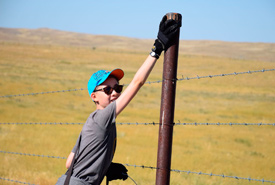
A young CV capping the posts with post caps provided by Mosaic potash. (Photo by NCC)
Over the years, the Nature Conservancy of Canada’s (NCC’s) Conservation Volunteers (CV) have helped protect habitat for many species, all while creating a budding community among nature lovers across Canada.
Since 2006, NCC’s CV program has engaged more than 16,000 Canadians at 1,361 events from coast to coast. At these gatherings, volunteers work together toward specific conservation goals set out by NCC. Whether it is a coastal cleanup or surveying an area for rare species, each event works like a paint stroke in the conservation masterpiece.
Simply put, volunteering is one of the essentials of conservation success. Much like learning the ABCs, it creates a foundation and serves as a gateway for Canadians to learn the language of the land.
Learn more about NCC’s CV program through the ABCs, below:
A – All ages
Volunteers of all ages are welcome to join in and lend a hand for nature.
B – Buckthorn
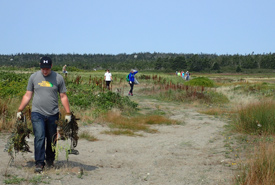
Garbage clean up in Brier Island, NS (Photo by NCC)
This pesky invasive species is known to wreak havoc on native plants, which is why CVs work tirelessly to remove it.
C – Cleanups
From sandy shores to lush forests, cleaning up garbage, junk and debris is one way CVs are helping species thrive on NCC properties.
D – Digging
From digging burrows for burrowing owls in BC, to planting trees in Quebec, you can always count on a CV to dig deep for conservation.
E – Exploration
Volunteering for an event opens up your horizons. From visiting a new place, to seeing a species for the first time, there’s tons to explore.
F – Fences
Whether it’s removing, fixing or installing, CVs lend a hand in ensuring fencing on our properties is safe for species and visitors alike.
G – Garlic mustard
One of the major threats to forest ecosystem health in eastern Canada, persistent pulling of garlic mustard by CVs helps combat its invasion on our properties.
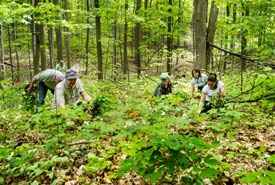
Volunteers pulling garlic mustard at Happy Valley Forest, ON (Photo by Miguel Hortiguela)
H – Hazel Bird Nature Reserve
Hazel Bird Nature Reserve in Ontario, with its stunning grassland prairie and strong oak trees, is one of the many NCC properties that have benefited from volunteer work.
I – iNaturalist
iNaturalist is a citizen science platform that NCC uses to engage volunteers in collecting species data during events across Canada.
J – Japanese barberry
CVs have improved habitat in one of the largest remaining tracts of Carolinian forest on the Niagara Peninsula by pulling out this invasive plant.
K – Kenauk
The Kenauk property in Quebec is a hot spot for birds, and is one of our CVs favourite areas to monitor migratory species at risk.
L – Live staking
By planting dogwood and willow live stakes in various provinces across Canada, CVs help to stabilize stream banks by keeping soil out of the water.
M – Monitoring
By keeping track of the species living on NCC properties, CVs help to inform our staff about the best steps to help protect their habitats.
N – Native species
One of the main objectives of the CV program is to support native habitats — there are almost too many native species helped by volunteers across Canada to count!
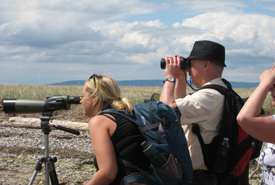
CVs monitoring piping plover from a safe distance at Sandy Point, AB (Photo by NCC)
O – Ontario
In 2001, we established a formal volunteer program in Ontario, in partnership with Ontario Nature (then known as the Federation of Ontario Naturalists), which eventually transformed into our current-day CV program.
P – Piping plovers
From cleaning up prospective nesting habitat to monitoring birds on our properties, CVs work to ensure this federally endangered bird is on its way to recovery.
Q – Queen snake
This nationally endangered species is protected on NCC properties along the Maitland River, Ontario — an area commonly stewarded by our volunteers.
R – Rocky Mountains
CV events occur in diverse landscapes across Canada, introducing many volunteers to new places for exploring, such as the Canadian Rocky Mountains.
S – Skills
Through volunteering, CVs have learned various skills, such as team building, how to use power tools safely and species identification.
T – Teamwork
There is no community quite like the network of CVs across Canada — all of whom work together to help conserve landscapes.
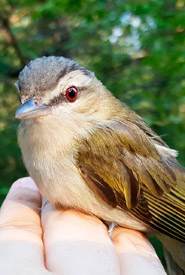
Red-eyed vireo (Photo by NCC)
U – Upcycling
Using everyday items, volunteers have created conservation solutions for species, such as using tin cans to craft nesting spots for native bee species or using old pipe caps to prevent bird mortality at Old Man on His Back Ranch in Saskatchewan.
V – Vireos
Perhaps you’ll spot a species of vireo at the next CV birding event.
W – Waterfowl surveys
By keeping a watchful eye on waterfowl, volunteers collect data that assists in building conservation strategies for specific bird populations. Join one of our waterfowl surveys in Atlantic Canada this fall.
X – X-ray vision
Surveys looking for diverse species (from common to rare) have taken place in various habitats across the country — each requiring X-ray-like vision to spot fast-moving critters.
Y – Yellow Quill Prairie
Volunteers have joined NCC staff on this Manitoba property to look for reptiles and have witnessed smooth greensnake and red-bellied snake.
Z – Zingers
You never know what you may find while at an event, but one thing is for sure: There are plenty of outstanding volunteers in your company in cheery moods!


